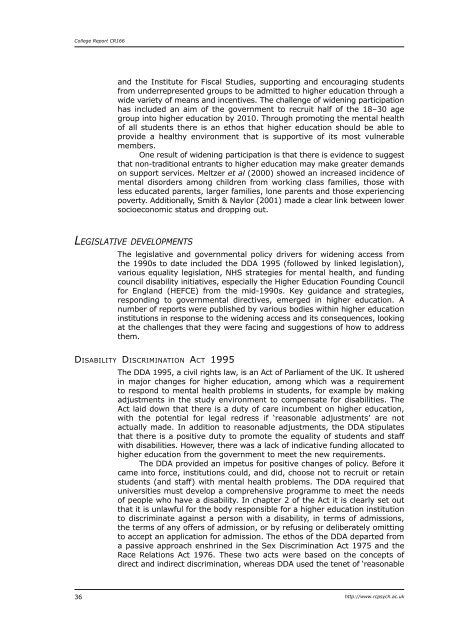Mental health of students in higher education
Mental health of students in higher education - Royal College of ...
Mental health of students in higher education - Royal College of ...
- No tags were found...
Create successful ePaper yourself
Turn your PDF publications into a flip-book with our unique Google optimized e-Paper software.
College Report CR166and the Institute for Fiscal Studies, support<strong>in</strong>g and encourag<strong>in</strong>g <strong>students</strong>from underrepresented groups to be admitted to <strong>higher</strong> <strong>education</strong> through awide variety <strong>of</strong> means and <strong>in</strong>centives. The challenge <strong>of</strong> widen<strong>in</strong>g participationhas <strong>in</strong>cluded an aim <strong>of</strong> the government to recruit half <strong>of</strong> the 18–30 agegroup <strong>in</strong>to <strong>higher</strong> <strong>education</strong> by 2010. Through promot<strong>in</strong>g the mental <strong>health</strong><strong>of</strong> all <strong>students</strong> there is an ethos that <strong>higher</strong> <strong>education</strong> should be able toprovide a <strong>health</strong>y environment that is supportive <strong>of</strong> its most vulnerablemembers.One result <strong>of</strong> widen<strong>in</strong>g participation is that there is evidence to suggestthat non-traditional entrants to <strong>higher</strong> <strong>education</strong> may make greater demandson support services. Meltzer et al (2000) showed an <strong>in</strong>creased <strong>in</strong>cidence <strong>of</strong>mental disorders among children from work<strong>in</strong>g class families, those withless educated parents, larger families, lone parents and those experienc<strong>in</strong>gpoverty. Additionally, Smith & Naylor (2001) made a clear l<strong>in</strong>k between lowersocioeconomic status and dropp<strong>in</strong>g out.Legislative developmentsThe legislative and governmental policy drivers for widen<strong>in</strong>g access fromthe 1990s to date <strong>in</strong>cluded the DDA 1995 (followed by l<strong>in</strong>ked legislation),various equality legislation, NHS strategies for mental <strong>health</strong>, and fund<strong>in</strong>gcouncil disability <strong>in</strong>itiatives, especially the Higher Education Found<strong>in</strong>g Councilfor England (HEFCE) from the mid-1990s. Key guidance and strategies,respond<strong>in</strong>g to governmental directives, emerged <strong>in</strong> <strong>higher</strong> <strong>education</strong>. Anumber <strong>of</strong> reports were published by various bodies with<strong>in</strong> <strong>higher</strong> <strong>education</strong><strong>in</strong>stitutions <strong>in</strong> response to the widen<strong>in</strong>g access and its consequences, look<strong>in</strong>gat the challenges that they were fac<strong>in</strong>g and suggestions <strong>of</strong> how to addressthem.Disability Discrim<strong>in</strong>ation Act 1995The DDA 1995, a civil rights law, is an Act <strong>of</strong> Parliament <strong>of</strong> the UK. It ushered<strong>in</strong> major changes for <strong>higher</strong> <strong>education</strong>, among which was a requirementto respond to mental <strong>health</strong> problems <strong>in</strong> <strong>students</strong>, for example by mak<strong>in</strong>gadjustments <strong>in</strong> the study environment to compensate for disabilities. TheAct laid down that there is a duty <strong>of</strong> care <strong>in</strong>cumbent on <strong>higher</strong> <strong>education</strong>,with the potential for legal redress if ‘reasonable adjustments’ are notactually made. In addition to reasonable adjustments, the DDA stipulatesthat there is a positive duty to promote the equality <strong>of</strong> <strong>students</strong> and staffwith disabilities. However, there was a lack <strong>of</strong> <strong>in</strong>dicative fund<strong>in</strong>g allocated to<strong>higher</strong> <strong>education</strong> from the government to meet the new requirements.The DDA provided an impetus for positive changes <strong>of</strong> policy. Before itcame <strong>in</strong>to force, <strong>in</strong>stitutions could, and did, choose not to recruit or reta<strong>in</strong><strong>students</strong> (and staff) with mental <strong>health</strong> problems. The DDA required thatuniversities must develop a comprehensive programme to meet the needs<strong>of</strong> people who have a disability. In chapter 2 <strong>of</strong> the Act it is clearly set outthat it is unlawful for the body responsible for a <strong>higher</strong> <strong>education</strong> <strong>in</strong>stitutionto discrim<strong>in</strong>ate aga<strong>in</strong>st a person with a disability, <strong>in</strong> terms <strong>of</strong> admissions,the terms <strong>of</strong> any <strong>of</strong>fers <strong>of</strong> admission, or by refus<strong>in</strong>g or deliberately omitt<strong>in</strong>gto accept an application for admission. The ethos <strong>of</strong> the DDA departed froma passive approach enshr<strong>in</strong>ed <strong>in</strong> the Sex Discrim<strong>in</strong>ation Act 1975 and theRace Relations Act 1976. These two acts were based on the concepts <strong>of</strong>direct and <strong>in</strong>direct discrim<strong>in</strong>ation, whereas DDA used the tenet <strong>of</strong> ‘reasonable36 http://www.rcpsych.ac.uk





